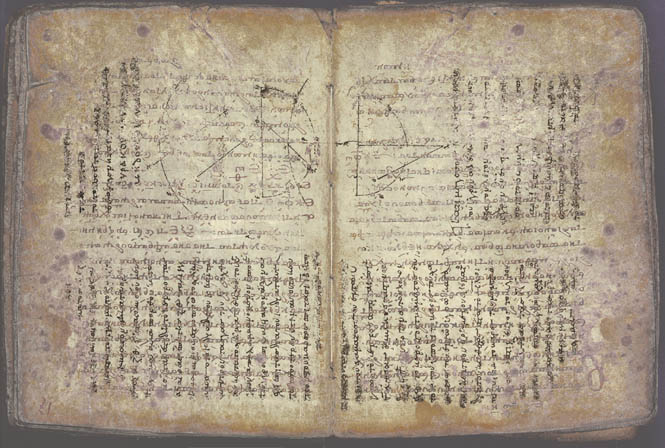Ancient Greek Research Paper on Symbols
Learning from Archimedes 250 BC about Size of the Universe and Sounds Art, Education, Symbols and Signs, Quotes, defaultEsoteric teachings of Golden Citizens of Ancient Greece
Ancient Greek Numbers and Sounds
Learning from symbols, and sounds of the first ever Research Paper by Archimedis Syracusani
Hellenistic mathematicians in the 500 BC, prefered using a system of numbers based on the alphabet. To indicate that a letter is a number, they would place a horizontal line above the symbol.

Archimedes_Palimpsest 250 BC an orthodox Christina prayer text 13th century revealed works by Archimedes thought to have been lost
The School of Athens or aθήνα and Numbers with Archimedes of Syracuse
What is now known as "Attic numerals" were in use 700 BC, in the region of Attica, the city of Athens down to the Aegean Sea.
Archimedes of Syracuse or Αρχιμήδης 287 – 212 BC, was an Ancient Greek mathematician, physicist, engineer, inventor, and astronomer, and he is considered one of the greatest mathematician of all time, He was the first to calculate the accurate approximation of pi, defining the spiral bearing his name, he hypotheses that the Earth revolves around the Sun on the circumference of a circle. Archimedes was killed by a Roman soldier, and his original work was “lost” for thousands of years.
The work, also known in Latin as Archimedis Syracusani Arenarius & Dimensio Circuli, is eight pages long in translation, is the Humanity's first matematical research paper.
Archimedes presents his callculation done for the King, stating that the large numbers were given to him to execute this exciting task, to discover the amount to sand that can fit into the Universe. The Sand Reckoner (Greek: Ψαμμίτης, Psammites) is the name of this work.

Estimating the grains of Sand in Universe Archimade
Can you just imagine the complexity of this task, can you comprehend the advances in science, and the thought form, if the Syracusan king Gelo II, pays the Philosopher Archimedis Syracusani to execute this research and leave it written for the future scientists.
In order to do this, he had to estimate the size of the universe!
h3>Ancient Greek Hellenistic Mathematicians and The Sand Reckoner
Archimedes counts in groups of 10000 (myriad), e.g. 10,0000 instead of 100,000. Within his work he refers to:
1 as “not a number” - for at the time it represented the consciousness going forth to express itself... In the latine translations it has been translated as “the unit”
The first four numbers symbolized the musica universalis and the Cosmos:
1 = Unity or Monad, zero dimension (a point), supreme God that has not materialised as yet
2 = Dyad, one dimension (a line of two points)
3 = Triad, two dimensions, a plane defined by a triangle
4 = Kosmos (Tetrad), a tetrahedron defined by four points
The four rows add up to ten, which was unity of a higher order or the Dekad.
The Tetractys symbolizes the four elements: fire, air, water, and earth
number translation explanation
1 unit not a number one of something
8 eight of units that are not a number grouped together
10 Decad ten units grouped together
100 He katontad one hundred units grouped together hundred one-hundred somethings
1000 CHiliad one thousand units grouped together thousand one thousand somethings
1,0000 Myriad 10,000 units grouped together, ten-thousand ten-thousand somethings
Since the Ancient Greek number system is based on the alphabet, symbolically, each Letter has a precise “meaning”, “numeral frequency”, or “philosophical concept”. Archimede for example, speaks of 'one', 'two', 'three', but also of 'first', 'second', third,. for 20 he would use: 2 tens or 2 deka, etc.
His numbers indicate nouns like: monad, dyad, ennead, octad, decad (or decade). These are all philosophical concepts
So, for example, it is wrong to think of an octad as a set of eight units. It is eight units grouped together as a single unit.
This system became the prefered system for Hellenistic mathematicians. This is where all the schools were, in Athens and its Medditeranean surrounding.
There are three sets of 9 numerals from the Ionian alphabet, 24 letters + Supreme Omnipresent God sounds represented as numbers: 6 or Vau, 90 Koppa, 900 Sanpi, the symbols whose sounds today we do not know, for they were hidden by the Priests as sacred.
1,0000 Myriad is 10,000 units grouped together. Knowing that M was later translated into the Latin as 1,000, it looks like the Ancient Romans were in trade 10 x overcharging the Ancient Greeks, claiming a 1,000 for a 10,000 figure.
In the following list, for their resemblence to the Serbian cyrilic letters symbols, I substituted them with Dj, Dž, Sh. The Cyrillic letters that are unique to Serbian are Ђ (Dj) Ч (CH), Љ (LJ). Њ (NJ) Џ (Dž)
1 A 2 B 3 G 4 D 5 E 6 Ϛ Vau 7 Z 8 H 9 Theta theta
10 I 20 K 30 L 40 M 50 N 60 xi 70 O 80 pi 90 Ϟ *Koppa
100 R 200 S 300 T 400 U 500 phi 600 chi 700 psi 800 omega 900 *Sanpi
|
|
YHW |
|
|
|
|
|
|
|
|
| |||
|---|---|---|---|---|---|---|---|---|---|---|---|---|---|
|
A α |
Α |
1 |
I |
ι |
Ι |
10 |
R ρ |
Ρ |
100 |
+ |
|||
|
B β |
Β |
2 |
K |
κ |
Κ |
20 |
S σ |
Σ |
200 |
||||
|
G γ |
Γ |
3 |
L |
λ |
Λ |
30 |
T τ |
Τ |
300 |
||||
|
D δ |
Δ |
4 |
M |
μ |
Μ |
40 |
U υ |
Υ |
400 |
||||
|
E ε |
Ε |
5 |
N |
ν |
Ν |
50 |
F φ |
Φ |
500 |
||||
|
C Ц |
Ϛ |
6 |
Ж Ž |
ξ |
Ξ |
60 |
X χ |
Χ |
600 |
||||
|
Z ζ |
Ζ |
7 |
O |
ο |
Ο |
70 |
Ψ џ DŽ |
Ψ |
700 |
||||
|
η Њ |
eta |
8 |
P |
π |
Π |
80 |
ω ш Š Sh |
Ω |
800 |
||||
|
H Θ |
Θ theta |
9 |
koppa* |
Č Ч |
Ϟ |
90 |
sampi* Dj Ђ ђ |
Ϡ |
900 |
1 unit not a number
8 octet eight of 1s (units) grouped together H
10 Decad ten units grouped together
100 Hekatontad one hundred units grouped together
1000 Chiliad one thousand units grouped together
Vau, koppa, and sampi are obsolete characters so their true sound is hidden within “W”, “K”, and “S”. Greek letter names are acrophonic: the names of the letters α, β, γ, δ, are spelled with the respective letters: αλφα (alpha), βήτα (beta), γάμμα (gamma), δέλτα (delta) so Koppa, Vau and Sampi
Archimedes, The Sand Reckoner Quotes
“In fact the names of the numbers up to the name of ten-thousand happen to have been provided to us, and beyond the name of ten-thousand we ascertain a number of ten-thousands of units when we say, "even up to ten-thousand myriads." from Archimedes, The Sand Reckoner
Check would you be able to solve this one “For let there be some numbers in proportion from a unit, A, B, C, D, E, F, G, H, I, J, K, and let A be a unit, and let D be multiplied by H, and let the number that arises be X. Let K be taken from the proportion as being as distant from H as D is from unit A. We must prove that X is equal to K. And so since, given that the numbers are proportional, D from A and K from H have equal distances, D to A has the same ratio as K to H. But D is a multiple of A by D. Therefore, K is also a multiple of H by D. Thus K is equal to X.” from Archimedes, The Sand Reckoner
“Given these as supposed, the following will also be proved, namely the diameter of the world is less than ten-thousand-times the diameter of the earth, and furthermore the diameter of the world is less than 100 ten-thousand-times ten-thousand stadia [100,0000,0000]. For since it is supposed that the diameter of the sun is not larger than three-hundred times the diameter of the moon,... from Archimedes, The Sand Reckoner
Archimedes presents us with an answer.
And so I suppose these concerning the magnitudes and distances, while concerning the sand these. If there is a magnitude composed from the sand not larger than a poppy-seed, the number of it is not larger than ten-thousand, while the diameter of the poppy-seed is not larger than a fortieth-part of an inch...” from Archimedes, The Sand Reckoner
Summary
10000 grains of sand = 1 poppyseed
40 poppy-seeds = 1 inch in length
Hence, 1 inch x 1 inch = 10000 x 40 x 40 = 1600,0000 grains of sand






Ancient Greek Research Paper on Symbols No comments on Ancient Greek Research Paper on Symbols: